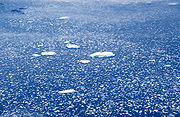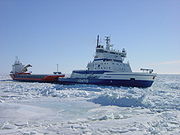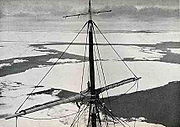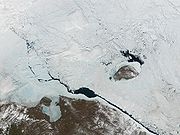
Drift ice
Encyclopedia

Ice
Ice is water frozen into the solid state. Usually ice is the phase known as ice Ih, which is the most abundant of the varying solid phases on the Earth's surface. It can appear transparent or opaque bluish-white color, depending on the presence of impurities or air inclusions...
that floats on the surface of the water in cold regions, as opposed to fast ice
Fast ice
Fast ice is sea ice that has frozen along coasts along the shoals, or to the sea floor over shallow parts of the continental shelf, and extends out from land into sea. In Antarctica, fast ice may also extend between grounded icebergs...
, which is attached ("fastened") to a shore. Usually drift ice is carried along by winds and sea currents, hence its name, "drift ice".
When the drift ice is driven together into a large single mass, it is called pack ice. Wind and currents can pile up ice to form ridges three to four metres high, creating obstacles difficult for powerful icebreaker
Icebreaker
An icebreaker is a special-purpose ship or boat designed to move and navigate through ice-covered waters. Although the term usually refers to ice-breaking ships, it may also refer to smaller vessels .For a ship to be considered an icebreaker, it requires three traits most...
s to penetrate. Typically areas of pack ice are identified by high percentage of surface coverage by ice: e.g., 80-100%.
An ice floe is a large piece of drift ice that might range from tens of metres (yards) to several kilometres in diameter
Diameter
In geometry, a diameter of a circle is any straight line segment that passes through the center of the circle and whose endpoints are on the circle. The diameters are the longest chords of the circle...
. Wider chunks of ice are called ice fields.
The two major ice packs are the Arctic ice pack and the Antarctic ice pack.
In many areas such as the Baltic
Baltic Sea
The Baltic Sea is a brackish mediterranean sea located in Northern Europe, from 53°N to 66°N latitude and from 20°E to 26°E longitude. It is bounded by the Scandinavian Peninsula, the mainland of Europe, and the Danish islands. It drains into the Kattegat by way of the Øresund, the Great Belt and...
, drift ice is traditionally a seasonal event, appearing in winter and vanishing in warmer seasons.
Seasonal ice drift in the Sea of Okhotsk
Sea of Okhotsk
The Sea of Okhotsk is a marginal sea of the western Pacific Ocean, lying between the Kamchatka Peninsula on the east, the Kuril Islands on the southeast, the island of Hokkaidō to the far south, the island of Sakhalin along the west, and a long stretch of eastern Siberian coast along the west and...
by the northern coast of Hokkaidō
Hokkaido
, formerly known as Ezo, Yezo, Yeso, or Yesso, is Japan's second largest island; it is also the largest and northernmost of Japan's 47 prefectural-level subdivisions. The Tsugaru Strait separates Hokkaido from Honshu, although the two islands are connected by the underwater railway Seikan Tunnel...
, Japan
Japan
Japan is an island nation in East Asia. Located in the Pacific Ocean, it lies to the east of the Sea of Japan, China, North Korea, South Korea and Russia, stretching from the Sea of Okhotsk in the north to the East China Sea and Taiwan in the south...
has become a tourist attraction of this area with harsh climate
Climate
Climate encompasses the statistics of temperature, humidity, atmospheric pressure, wind, rainfall, atmospheric particle count and other meteorological elemental measurements in a given region over long periods...
, and is one of the 100 Soundscapes of Japan
100 Soundscapes of Japan
In 1996, as part of its efforts to combat noise pollution and to protect and promote the environment, the Ministry of the Environment designated the . 738 submissions were received from all over the country and the 100 'best' were selected after examination by the Japan Soundscape Study Group...
. The Sea of Okhotsk is the southernmost area in the Northern hemisphere
Northern Hemisphere
The Northern Hemisphere is the half of a planet that is north of its equator—the word hemisphere literally means “half sphere”. It is also that half of the celestial sphere north of the celestial equator...
where drift ice may be observed.
Drift ice affects:
- Security of navigationNavigationNavigation is the process of monitoring and controlling the movement of a craft or vehicle from one place to another. It is also the term of art used for the specialized knowledge used by navigators to perform navigation tasks...
- Climatic impact (see Polar ice packsPolar ice packsPolar ice packs are large areas of pack ice formed from seawater in the Earth's polar regions, known as polar ice caps: the Arctic ice pack of the Arctic Ocean and the Antarctic ice pack of the Southern Ocean, fringing the Antarctic ice sheet. Polar packs significantly change their size during...
) - Geological impact
- Biosphere influence (see Ecology of sea ice)
The most important areas of pack ice are the polar ice packs
Polar ice packs
Polar ice packs are large areas of pack ice formed from seawater in the Earth's polar regions, known as polar ice caps: the Arctic ice pack of the Arctic Ocean and the Antarctic ice pack of the Southern Ocean, fringing the Antarctic ice sheet. Polar packs significantly change their size during...
formed from seawater
Seawater
Seawater is water from a sea or ocean. On average, seawater in the world's oceans has a salinity of about 3.5% . This means that every kilogram of seawater has approximately of dissolved salts . The average density of seawater at the ocean surface is 1.025 g/ml...
in the Earth's polar region
Polar region
Earth's polar regions are the areas of the globe surrounding the poles also known as frigid zones. The North Pole and South Pole being the centers, these regions are dominated by the polar ice caps, resting respectively on the Arctic Ocean and the continent of Antarctica...
s: the Arctic ice pack of the Arctic Ocean
Arctic Ocean
The Arctic Ocean, located in the Northern Hemisphere and mostly in the Arctic north polar region, is the smallest and shallowest of the world's five major oceanic divisions...
and the Antarctic ice pack of the Southern Ocean
Southern Ocean
The Southern Ocean comprises the southernmost waters of the World Ocean, generally taken to be south of 60°S latitude and encircling Antarctica. It is usually regarded as the fourth-largest of the five principal oceanic divisions...
. Polar packs significantly change their size during seasonal changes of the year. Because of vast amounts of water added to or removed from the oceans and atmosphere
Atmosphere
An atmosphere is a layer of gases that may surround a material body of sufficient mass, and that is held in place by the gravity of the body. An atmosphere may be retained for a longer duration, if the gravity is high and the atmosphere's temperature is low...
, the behavior of polar ice packs has a significant impact on global changes in climate
Climate
Climate encompasses the statistics of temperature, humidity, atmospheric pressure, wind, rainfall, atmospheric particle count and other meteorological elemental measurements in a given region over long periods...
.
 |
 |
 |
See also
- IcebergIcebergAn iceberg is a large piece of ice from freshwater that has broken off from a snow-formed glacier or ice shelf and is floating in open water. It may subsequently become frozen into pack ice...
- Ice driftIce driftIce drift is movement of ice. An important type of ice drift is drift of the sea ice, i.e., of the drift ice. Unless specified otherwise, this article discusses the drift of the sea ice. The direction of the ice drift is the vector sum of the oceanic and atmospheric circulations, i.e., upper ocean...
- Polar ice packsPolar ice packsPolar ice packs are large areas of pack ice formed from seawater in the Earth's polar regions, known as polar ice caps: the Arctic ice pack of the Arctic Ocean and the Antarctic ice pack of the Southern Ocean, fringing the Antarctic ice sheet. Polar packs significantly change their size during...
- PolynyaPolynyaA polynya or polynia is an area of open water surrounded by sea ice. It is now used as geographical term for an area of unfrozen sea within the ice pack. It is a loanword from , , which means a natural ice hole, and was adopted in the 19th century by polar explorers to describe navigable...
- Sea iceSea iceSea ice is largely formed from seawater that freezes. Because the oceans consist of saltwater, this occurs below the freezing point of pure water, at about -1.8 °C ....
- Shelf iceShelf iceShelf ice can refer to the ice that forms when a portion of a lake surface freezes. It is often then washed upon the shore. This is common within the Great Lakes.-Formation:...
- Soviet and Russian manned drifting ice stationsSoviet and Russian manned drifting ice stationsSoviet and Russian manned drifting ice stations are important contributors to exploration of the Arctic. The stations are named North Pole Soviet and Russian manned drifting ice stations are important contributors to exploration of the Arctic. The stations are named North Pole Soviet and...
External links
- "Drift Ice as a Geologic Agent", video by US Geologic Survey
- "Ice in the Sea" : chapter from Nathaniel BowditchNathaniel BowditchNathaniel Bowditch was an early American mathematician remembered for his work on ocean navigation. He is often credited as the founder of modern maritime navigation; his book The New American Practical Navigator, first published in 1802, is still carried on board every commissioned U.S...
's American Practical Navigator - Cryosphere Today : Current Arctic sea ice conditions
- Data source for sea ice picture
- Marine Modeling and Analysis Branch
- Everything you ever wanted to know about sea ice but were afraid to ask
- Animation of the movement of sea ice, September 2003 through May 2004
- NSIDC Sea Ice Index
- Atlas of Antarctic Sea Ice Drift

